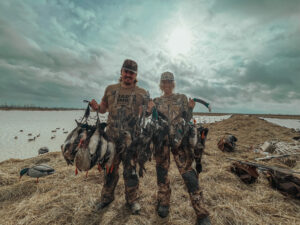

As summer approaches, many outdoor enthusiasts and conservationists turn their focus toward improving local duck habitats. A healthy and thriving duck habitat benefits not only the ducks but also other wildlife and the ecosystem as a whole. By taking proactive measures during the summer months, it is possible to significantly impact the quality of habitats just in time for the arrival of migrating ducks during the fall.
Efforts to enhance duck habitats can range from working with conservation groups such as Ducks Unlimited to implementing do-it-yourself projects on your own land. A key aspect of creating an inviting habitat for ducks is to ensure there is an abundance of food and suitable nesting areas, which can be achieved through managing natural vegetation and providing water sources. Additionally, it is essential to recognize that factors such as season, weather, and local conditions can also influence the presence of ducks in any given area.
With a bit of planning and dedication, improving local duck habitats during the summer can lead to a rewarding and enjoyable waterfowl season for both hunters and bird watchers alike. By understanding the needs of these species, anyone can contribute to the efforts of enhancing and maintaining flourishing duck habitats that benefit all of us.
Importance of Duck Habitat
Duck habitat plays a crucial role in the overall health of waterfowl populations and the ecosystems they reside in. These habitats provide essential resources such as food, shelter, and breeding grounds for various waterfowl species.
Role of Waterfowl Conservation
Waterfowl conservation organizations like Delta Waterfowl work with private landowners to address large-scale habitat challenges and safeguard duck production. Their efforts ensure that ducks are offered a variety of seeds, tubers, and aquatic invertebrates necessary for their survival and reproduction. The conservation of these habitats also benefits other wildlife inhabiting the same ecosystems.
Efforts of such organizations include:
- Collaborating with landowners to enhance and restore wetlands
- Educating and raising awareness about the importance of waterfowl habitats
- Securing funding for habitat conservation
Conserving and managing duck habitat on private lands can increase waterfowl’ food availability and ultimately contribute to a more successful hunting season. According to the Noble Research Institute, summer management directly affects waterfowl habitats, making maintaining and improving them essential during this time.
Another vital aspect of duck habitat conservation is the natural plant management surrounding wetlands. Mossy Oak explains that it’s crucial to encourage wild wetland plants’ growth, as these plants provide diverse food sources essential for the ducks’ well-being.
In conclusion, understanding and protecting duck habitats is vital for the betterment of waterfowl and the ecosystems they inhabit. By working together, private landowners and waterfowl conservation organizations can significantly impact the preservation and improvement of these essential habitats.

Creating a Local Duck Habitat
Selecting the Right Land
Choosing the appropriate location for your duck habitat is crucial. Ideal locations include private land near ponds, lakes, or other bodies of water which are known to attract ducks and other waterfowl species. Open water and wetland areas are essential elements in a thriving duck habitat. It is beneficial to consult with experts, such as biologists from Ducks Unlimited, as they can provide valuable advice on selecting the best land for your duck habitat.
Developing a Pond or Wetland
Once you have chosen a suitable location, the next step is to develop a pond or wetland area to attract ducks. Depending on the size of the project and the existing landscape, permits may be required to ensure compliance with regulatory guidelines. Consult with your local U.S. Army Corps of Engineers district for any necessary permits or restrictions.
Constructing ponds or wetlands involves managing water levels, monitoring plant growth, and promoting natural food sources. Implementing moist-soil management methods by periodically flooding and then draining the area encourages the development of moist soil grasses, which serve as a vital food source for ducks and other waterfowl.
Managing Natural Food Sources
To maintain a thriving duck habitat, managing the available food sources is essential. Ducks consume a wide variety of food items, including:
- Aquatic insects
- Invertebrates
- Natural vegetation
By encouraging the growth of these food sources, you can ensure that ducks within your habitat have ample nourishment throughout the year. Planting a diverse mix of native vegetation within the pond or wetland area is also recommended. This can help support ducks’ different life stages, providing cover, food resources, and nesting grounds.
In addition, consider working alongside local farmers and landowners to establish adjacent areas of agricultural crops that serve as supplementary food sources. Delta Waterfowl suggests planting corn, milo, wheat, millet, or other grains popular with ducks in the spring and flooding fields in late summer to create an ideal feeding environment.
Creating a healthy and productive duck habitat requires careful planning, collaboration, and ongoing management practices. By selecting the right land, developing ponds and wetlands, and managing natural food sources, you can provide a thriving habitat for local ducks and contribute to the overall health and diversity of the ecosystem.
Enhancing the Habitat
Duck habitats can benefit greatly from some summer preparation. This section will discuss three key strategies to improve your local duck habitat: adding a buffer zone, providing cover and vantage points, and maintaining freshwater sources.
Adding a Buffer Zone
One way to enhance a duck habitat is by creating a buffer zone. Buffer zones are areas of vegetation that separate the habitat from surrounding disturbances, such as roads, buildings, or agricultural fields. These buffers provide additional space for ducks to thrive and help protect the habitat from pollution, pests, and other threats. To create an effective buffer zone:
- Plant native grasses, shrubs, and trees around the habitat’s perimeter
- Maintain a minimum width of 15-30 feet, depending on the size of your habitat
- Regularly monitor and manage invasive plant species in the buffer zone
Providing Cover and Vantage Points
Cover and vantage points are crucial for ducks to rest, breed, and feed safely. These features contribute to a healthy and functional habitat. Some ways to provide cover and vantage points include:
- Installing nesting boxes for cavity-nesting duck species
- Planting or preserving natural cover such as wetland vegetation, grasses, or shrubs
- Creating small islands or floating platforms within the habitat for ducks to rest and preen
- Ensuring a varied landscape with different elevations and vegetation types for ducks to utilize

Maintaining Fresh Water Sources
Maintaining fresh water sources is essential for the overall health of the duck habitat. Ducks require clean water for drinking, bathing, and nesting. To ensure the habitat has fresh water throughout the summer, consider the following:
- Monitor the water quality regularly, checking for pollutants or excessive algae growth
- Install aeration systems or fountains to maintain oxygen levels and prevent stagnant water
- Employ water-control structures to manage water levels appropriately for the habitat
- Minimize soil erosion and nutrient runoff with proper landscaping and vegetation management
By incorporating these strategies, you can significantly improve your local duck habitat and create a thriving environment for these fascinating birds to flourish during summer.




